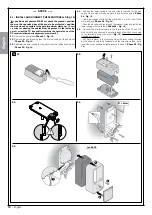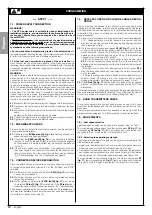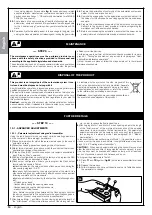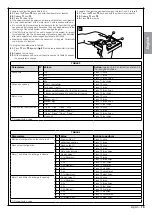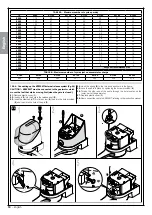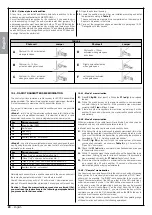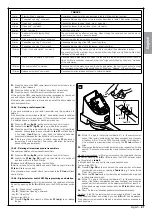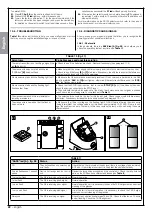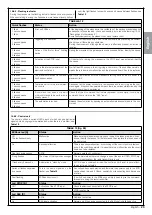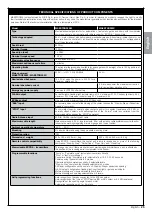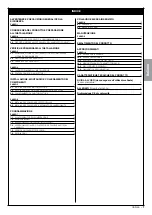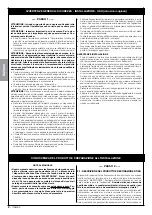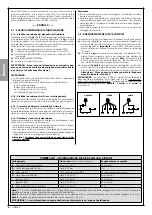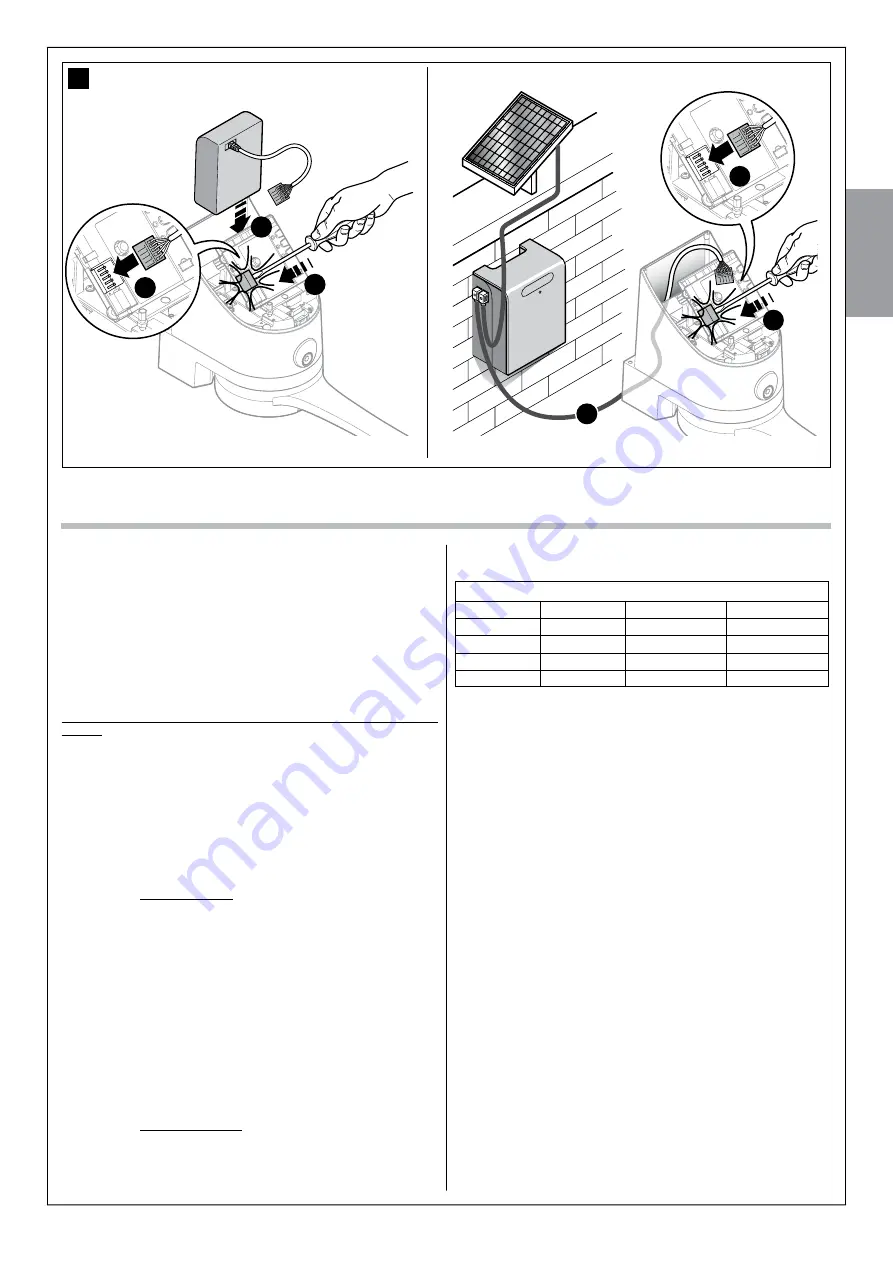
English –
17
English
10.2.3 - Calculation of maximum number of cycles per day
This product is expressly designed to also be able to operate with the
power supply system of the SOLEKIT solar energy model. Suitable tech-
nologies have been supplied to minimise the power consumption when
the automation is stopped, by turning off all the devices that are not
essential to the operation (for example the photocells or the key selector
light). In this way all the available energy is stored in the battery, and will be
used for the movement of the gate.
Caution! - When the automation mechanism is powered by SOLE-
KIT, it cannot and IT MUST NOT BE POWERED by the electricity
grid at the same time.
Usage limits:
maximum number of cycles per day, in a given period of
the year.
The SOLEKIT solar-powered system allows full energy independence for
the automation, whilst the energy produced by the solar energy panel
and stored in the battery remains higher than that consumed by the gate
manoeuvres. With a simple calculation is possible to estimate the maxi-
mum number of cycles per day that the automation can execute in a given
period of the year in order that this energy balance remains positive.
The first part of the
available energy calculation
, is explained in the
SOLEKIT instruction manual; the second part of
calculation of energy
consumed
and therefore, the maximum number of cycles per day, is
explained in this chapter.
Establish the available energy
To determine the available energy (see also the SOLEKIT instruction man-
ual) proceed as follows:
01.
In the ground map supplied in the SOLEKIT kit instruction manual,
locate the system installation point; then obtain the value of
Ea
and
the degrees of
latitude
of the location (Ex. Ea = 14 and degrees =
45°N)
02.
In the graphs (North or South) shown in the SOLEKIT kit instruction
manual, locate the curve which relates to the degrees of
latitude
of
the position (ex. 45°N)
03.
Choose the
period of the year
for which you wish to do the calcula-
tion, or choose
the lowest point
of the curve if you wish to carry
out the calculation for
the harshest period
of the year; then find the
corresponding Am value (i.e., December, January: Am= 200)
04.
Calculate the available energy value
Ed
(produced by the panel) by
multiplying: Ea x Am = Ed (i.e. Ea = 14; Am = 200 thus Ed = 2800)
Establish the energy consumed
To calculate the energy consumed by the automation proceed as follows:
05.
In the table below choose the box corresponding to the intersec-
tion of the row with the
weight
and the column with the
opening
angle
of the gate. The box contains the
severity index
(K) of each
manoeuvre (i.e. WU200S with 130kg leaf and opening of 100°; K =
106).
Opening angle
Leaf weight
≤95° (B≈250)* 95-105° (B≈180)* 105-110°(B≈70)*
< 100 kg
82
96
103
100-125 kg
103
121
130
125-150 kg
128
149
160
150-175 kg
157
184
197
(
*
) the value of B shown in the table represents the optimum value; in the event
that B is less than this value, add 20% to the K value shown in the table.
06.
In
table A
below, select the box corresponding to the intersection of
the row with the value of Ed and the column with the value of K. The
box contains the maximum possible number of cycles per day (e.g.
Ed= 2800 and K= 106; daily cycles ≈ 22)
If the number obtained is too low for the intended use, or falls within the
“not recommended usage area”, you can evaluate the use of 2 or more
solar power panels or a solar power panel of greater power. Contact the
Nice Support Service for further information.
The method described, allows you to calculate the maximum possible
number of cycles
per day
that the automation is capable of carrying out,
according to the solar energy supplied. The calculated value should be
considered as the average value and equal for all the days of the week.
Considering the presence of the accumulator, which acts as an energy
“store”, and considering that the accumulator allows you independent
automation even during long periods of bad weather (when the solar
panel produces very little energy) it is therefore possible to occasionally
exceed the maximum number of cycles per day, provided that the aver-
age on 10-15dd is within the limits.
In
table B
below the maximum possible number of cycles is shown,
according to the
severity index
(K) of the manoeuvre, using
the stored
solar energy
of the accumulator. It is assumed that initially the accumula-
tor is fully charged (e.g., after a long period of good weather or after a refill
with the optional power supply model PCB) and that the operations are
carried out within a period of 30 days
When the accumulator has exhausted its energy, the led will start to report
on the discharged status of the battery with a short flash every 5 seconds,
accompanied by a “beep” sound.
2
1
3
1
2
3
23
1
2
Summary of Contents for Maestro300
Page 2: ......
Page 10: ...8 Français Français 4 OK 3 NO 2 NO 1 180 2 2 180 1 9 10 11 1 3 4 5 2 ...
Page 28: ......
Page 36: ...8 English English 4 OK 3 NO 2 NO 1 180 2 2 180 1 9 10 11 1 3 4 5 2 ...
Page 54: ......
Page 62: ...8 Italiano Italiano 4 OK 3 NO 2 NO 1 180 2 2 180 1 9 10 11 1 3 4 5 2 ...
Page 80: ......
Page 88: ...8 Polski Polski 4 OK 3 NO 2 NO 1 180 2 2 180 1 9 10 11 1 3 4 5 2 ...
Page 106: ......
Page 119: ......








